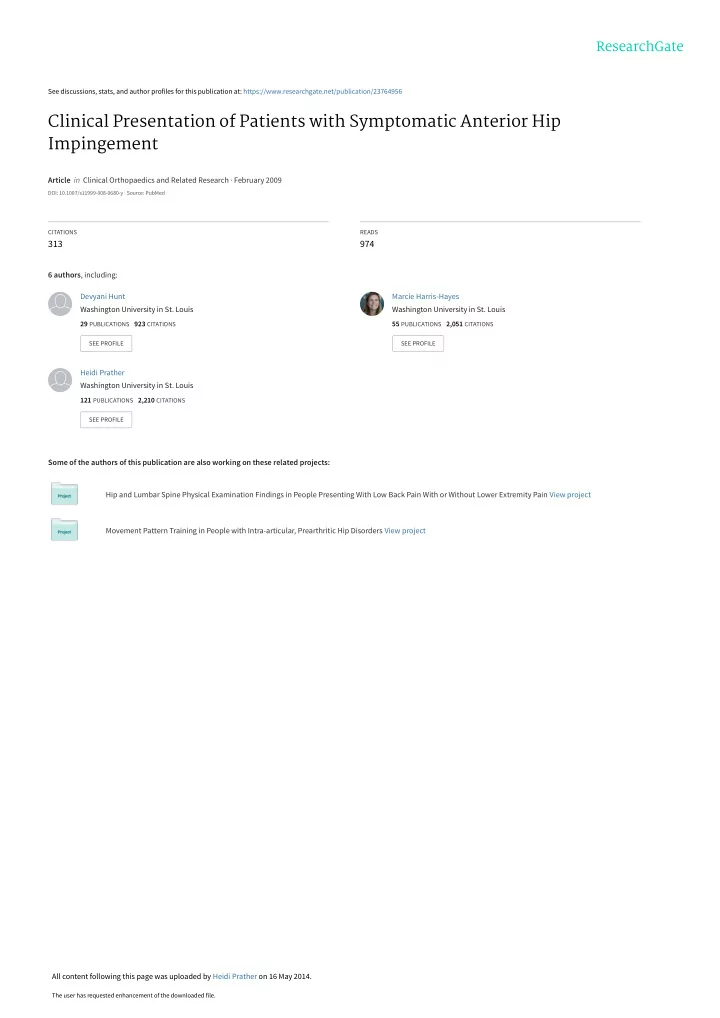

See discussions, stats, and author profiles for this publication at: https://www.researchgate.net/publication/23764956 Clinical Presentation of Patients with Symptomatic Anterior Hip Impingement Article in Clinical Orthopaedics and Related Research · February 2009 DOI: 10.1007/s11999-008-0680-y · Source: PubMed CITATIONS READS 313 974 6 authors , including: Devyani Hunt Marcie Harris-Hayes Washington University in St. Louis Washington University in St. Louis 29 PUBLICATIONS 923 CITATIONS 55 PUBLICATIONS 2,051 CITATIONS SEE PROFILE SEE PROFILE Heidi Prather Washington University in St. Louis 121 PUBLICATIONS 2,210 CITATIONS SEE PROFILE Some of the authors of this publication are also working on these related projects: Hip and Lumbar Spine Physical Examination Findings in People Presenting With Low Back Pain With or Without Lower Extremity Pain View project Movement Pattern Training in People with Intra-articular, Prearthritic Hip Disorders View project All content following this page was uploaded by Heidi Prather on 16 May 2014. The user has requested enhancement of the downloaded file.
Clin Orthop Relat Res (2009) 467:638–644 DOI 10.1007/s11999-008-0680-y SYMPOSIUM: FEMOROACETABULAR IMPINGEMENT: CURRENT STATUS OF DIAGNOSIS AND TREATMENT Clinical Presentation of Patients with Symptomatic Anterior Hip Impingement John C. Clohisy MD, Evan R. Knaus DO, Devyani M. Hunt MD, John M. Lesher MD, Marcie Harris-Hayes PT, Heidi Prather DO Published online: 7 January 2009 � The Association of Bone and Joint Surgeons 2008 Abstract Femoroacetabular impingement (FAI) is con- completed demographic and validated hip questionnaires sidered a cause of labrochondral disease and secondary (Baecke et al., SF-12, Modified Harris hip, and UCLA osteoarthritis. Nevertheless, the clinical syndrome associ- activity score). The average patient age was 35 years and ated with FAI is not fully characterized. We determined the 57% were male. Symptom onset was commonly insidious clinical history, functional status, activity status, and (65%) and activity-related. Pain occurred predominantly in physical examination findings that characterize FAI. We the groin (83%). The mean time from symptom onset to prospectively evaluated 51 patients (52 hips) with symp- definitive diagnosis was 3.1 years. Patients were evaluated tomatic FAI. Evaluation of the clinical history, physical by an average 4.2 healthcare providers prior to diagnosis exam, and previous treatments was performed. Patients and inaccurate diagnoses were common. Thirteen percent had unsuccessful surgery at another anatomic site. On exam, 88% of the hips were painful with the anterior Each author certifies that he or she has no commercial associations impingement test. Hip flexion and internal rotation in (eg, consultancies, stock ownership, equity interest, patent/licensing flexion were limited to an average 97 � and 9 � , respectively. arrangements, etc) that might pose a conflict of interest in connection The patients were relatively active, yet demonstrated with the submitted article. Partial support was received from a restrictions of function and overall health. These data may Zimmer Clinical Research Grant (JCC). This work was supported in part by Award Number UL1RR024992 from the National Center for facilitate diagnosis of this disorder. Research Resources (JCC). The content is solely the responsibility of Level of Evidence: Level II, diagnostic study. See the the authors and does not necessarily represent the official views of the Guidelines for Authors for a complete description of levels National Center for Research Resources or the National Institutes of Health. This work was also supported in part by the Curing Hip of evidence. Disease Fund (JCC). Each author certifies that his or her institution has approved the human protocol for this investigation and that all investigations were Introduction conducted in conformity with ethical principles of research, and that informed consent for participation in the study was obtained. Femoroacetabular impingement (FAI) results from mor- J. C. Clohisy ( & ) phological abnormalities of the proximal femur and/or Department of Orthopaedic Surgery, Washington University acetabulum which produce abnormal abutment of the School of Medicine, One Barnes-Jewish Plaza, Suite 11300 West acetabular rim and femoral head-neck junction [2, 3, 10, Pavilion, Campus Box 8233, St. Louis, MO 63110, USA e-mail: clohisyj@wudosis.wustl.edu 15, 17, 24, 29]. This mechanical abutment is most pro- nounced with hip flexion and internal rotation, and can be E. R. Knaus, D. M. Hunt, J. M. Lesher, H. Prather associated with pain, articular cartilage disease, labral Physical Medicine and Rehabilitation Section of the Department abnormalities, and progressive secondary osteoarthritis [10, of Orthopaedic Surgery, Washington University School of Medicine, St. Louis, MO, USA 17, 24]. FAI can be classified into two broad categories, namely cam (femoral-based) and pincer (acetabular-based). M. Harris-Hayes These can occur alone or in combination [2]. Typically, Program in Physical Therapy, Washington University School FAI affects young, active patients and is now recognized as of Medicine, St. Louis, MO, USA 123
Recommend
More recommend